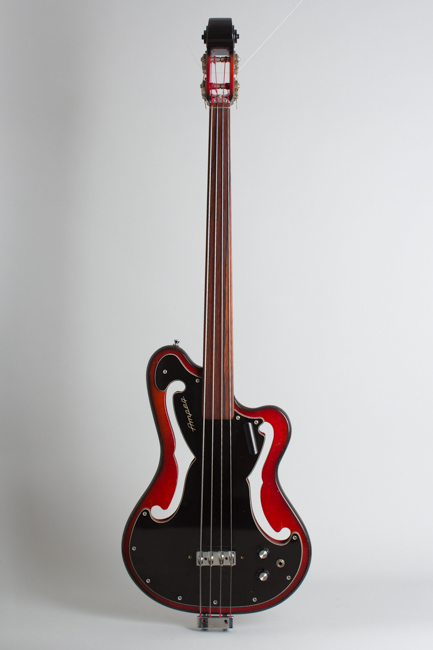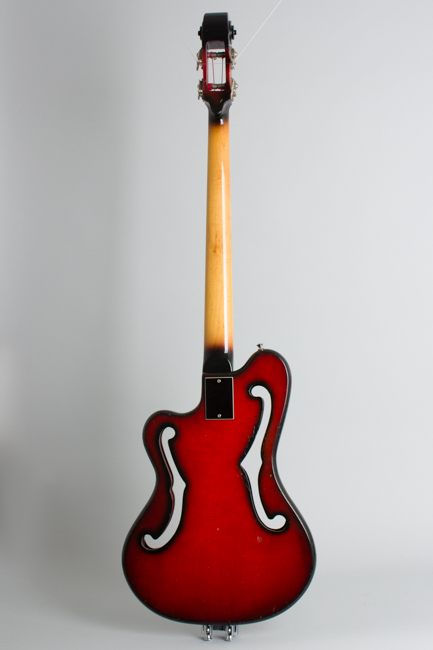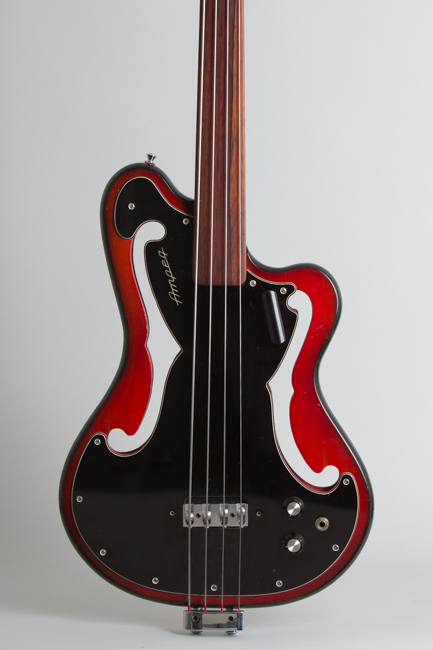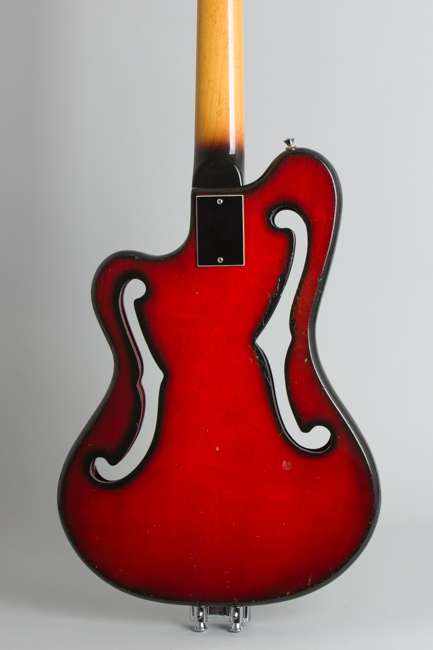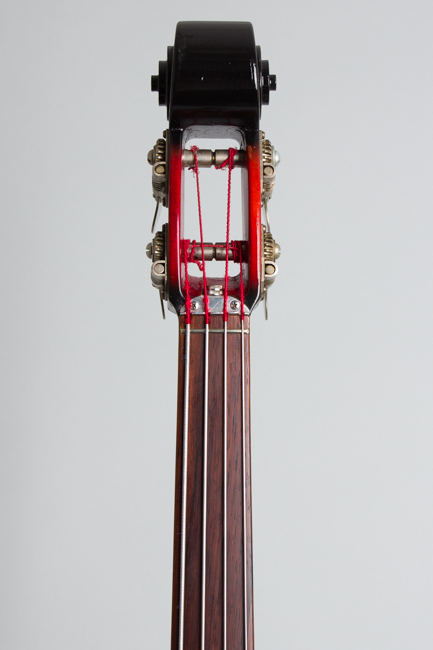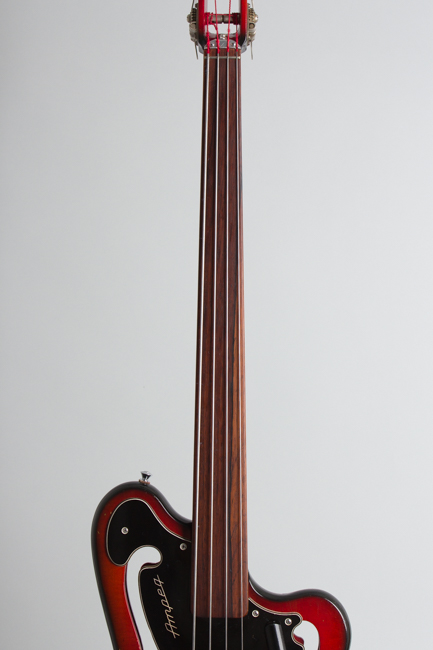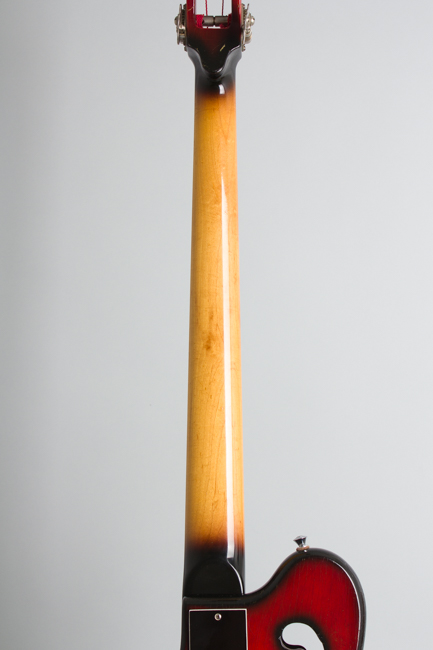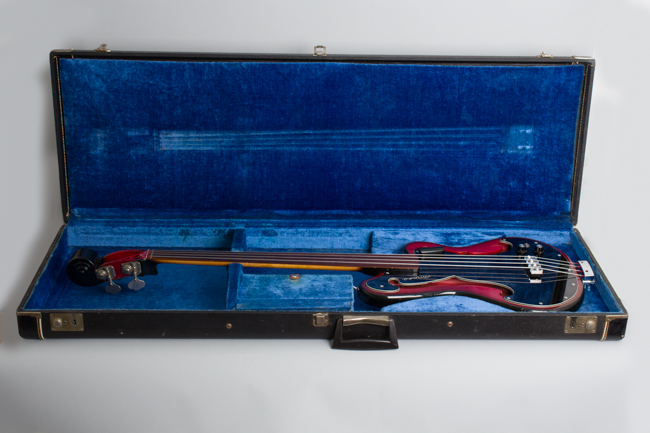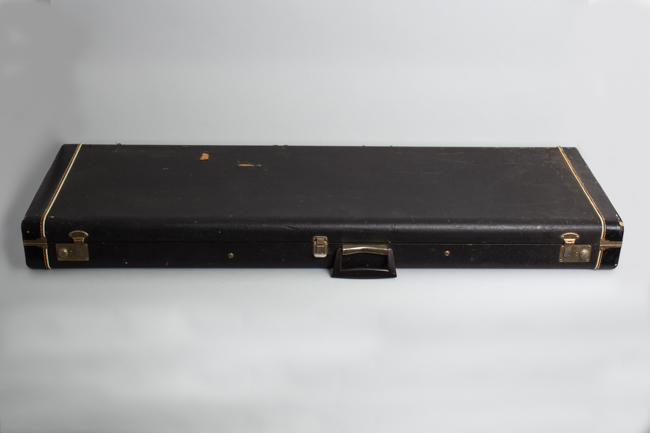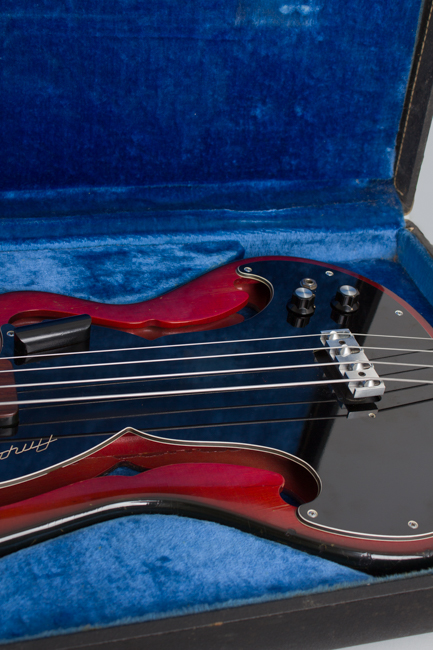Ampeg AUB-1 Electric Bass Guitar (1967)
This item is currently on hold.
Item # 12396
Prices subject to change without notice.
Ampeg AUB-1 Model Electric Bass Guitar (1967), made in Linden NJ, serial # 721, red/black sunburst finish, laminated maple body, maple neck with ebony fingerboard, original black hard shell case.
This is a super nice example of an original fretless Ampeg AUB-1 (Ampeg Unfretted Bass #1), the company's first production "horizontal" bass. While Ampeg had prospered with amplifiers since the 1950s, they made only half-hearted attempts to market instruments before 1966. The first was the fiberglass upright electric "Baby Bass" in 1961, and then they dabbled with importing re-branded Burns of London guitars. After that experiment ended, Ampeg decided to create a truly unique original design exclusively for bassists. These unique Ampeg "Scroll basses" were launched with some fanfare at the July 1966 NAMM show and have become something of a '60s classic, although never offering serious competition to the Fender Precision or Jazz bass.
These models were designed primarily by Ampeg employee Dennis Kager, but the instrument's character was strongly shaped by company founder Everett Hull's extreme distaste for the Fender bass. Hull was a purist who considered the upright bass to be the only legitimate low end instrument, and wanted to cater to traditional jazz and even classical players! To this end, this first Ampeg "Horizontal Bass" does not have a conventional magnetic pickup. It utilizes the same vibration-activated "Mystery Pickup" located under the bridge as the upright Baby Bass, allowing use of gut strings as well as steel. This point Hull insisted on, much to the chagrin of his employees who knew rock'n'roll players were the mass market. The unique scrolled headstock was another nod to bass tradition added on to Kager's design.
Ampeg had these instruments in production by September 1966, offering fretted and fretless models designated the AEB-1 and AUB-1. The bulk of production was from fall 1966 to the summer of '67, trailing off through late 1968. The fretless bass was a genuine innovation, designed to help upright players transition to the electric with the familiar microtonal fingerboard retained. This was a direct opposite concept to Fender's fretted "Precision" bass. Unfortunately in the ever higher-volume playing environments of the late 1960s, the microphonic and fairly low output pickup proved rather impractical on loud stages. The instrument was re-designed in 1968 (after Hull sold the company!) to use a magnetic pickup, but sales never really picked up. Electronic oddities aside, the rest of the instrument is extremely well-engineered, nicely made and quite functional.
This bass is a very nice example of the first fretless mystery-pickup model. The unusual offset body is built of laminate woods; the most notable feature is the large open f-holes cut in either side. The maple neck has a rosewood fingerboard inlaid only on the top edge with tiny dots to mark the positions. The bridge unit is milled aluminum and adjustable for height and intonation. The strings run to a separate heavy tailpiece mounted off the bottom of the body which can be adjusted to put more or less tension on the bridge. This setup requires special extra-long strings, although the scale length is the same as a Fender at 34". The serial number is stamped under the tailpiece bar.
This bass has a sound somewhere in between a "normal" fretless bass guitar and an upright. The acoustic-y twang of the "mystery" unit can be mellowed using the volume and tone controls, but it does take some experience to understand how to get a variety of sounds from the instrument. It can create a fairly convincing electric upright sound if used carefully, just as Everett Hull envisioned. While admittedly not to every taste, the original AUB-1 is a connoisseur's delight for the bassist with an eye to its unique character and history.
Overall length is 47 in. (119.4 cm.), 14 1/2 in. (36.8 cm.) wide at lower bout, and 1 1/4 in. (3.2 cm.) in depth, measured at side of rim. Scale length is 34 1/2 in. (876 mm.). Width of nut is 1 5/8 in. (41 mm.).
This bass shows just some light wear overall but remains nicely original and unaltered. These Ampeg "Scroll" basses have often fallen into disrepair or been modified over the last 50+ years; it is always a treat to find a well-preserved original like this. The bass has some typical finish checking, but by and large the original lacquer is well-preserved. Ampeg were new to finishing wood in 1966 and many early examples have significant finish loss or have been refinished due to the lacquer simply peeling off. This bass is mostly free of this cracking and flaking to the lacquer; there is some chipping along the rim, more from general wear than finish flaking, and the only significant loss is to the bottom edge of the body where a few spots have been touched up.
Beyond that, the bass shows just very minor play wear overall, with small chips to the headstock, including some minor touchups to the scroll. The back of the neck very little wear. The hard plastic pickguard is also very clean with little of the typical wear The fingerboard is well-preserved and the bass appears to have always been played with flatwound strings as there is no rutting of the board at all. The bass is currently set up with a set of Rotosound extra-long scale flatwound strings.
The hardware is original and complete except for the sliding bridge cover/mute bar, which as usual has gone missing. The huge original hard shell case has some scuffing and wear but it intact and fully functional; these Ampegs will fit in nothing else! This bass is eccentric-sounding for sure, but performs exactly as intended and is simply a lovely example of this unique New Jersey creation. Excellent Condition.
This is a super nice example of an original fretless Ampeg AUB-1 (Ampeg Unfretted Bass #1), the company's first production "horizontal" bass. While Ampeg had prospered with amplifiers since the 1950s, they made only half-hearted attempts to market instruments before 1966. The first was the fiberglass upright electric "Baby Bass" in 1961, and then they dabbled with importing re-branded Burns of London guitars. After that experiment ended, Ampeg decided to create a truly unique original design exclusively for bassists. These unique Ampeg "Scroll basses" were launched with some fanfare at the July 1966 NAMM show and have become something of a '60s classic, although never offering serious competition to the Fender Precision or Jazz bass.
These models were designed primarily by Ampeg employee Dennis Kager, but the instrument's character was strongly shaped by company founder Everett Hull's extreme distaste for the Fender bass. Hull was a purist who considered the upright bass to be the only legitimate low end instrument, and wanted to cater to traditional jazz and even classical players! To this end, this first Ampeg "Horizontal Bass" does not have a conventional magnetic pickup. It utilizes the same vibration-activated "Mystery Pickup" located under the bridge as the upright Baby Bass, allowing use of gut strings as well as steel. This point Hull insisted on, much to the chagrin of his employees who knew rock'n'roll players were the mass market. The unique scrolled headstock was another nod to bass tradition added on to Kager's design.
Ampeg had these instruments in production by September 1966, offering fretted and fretless models designated the AEB-1 and AUB-1. The bulk of production was from fall 1966 to the summer of '67, trailing off through late 1968. The fretless bass was a genuine innovation, designed to help upright players transition to the electric with the familiar microtonal fingerboard retained. This was a direct opposite concept to Fender's fretted "Precision" bass. Unfortunately in the ever higher-volume playing environments of the late 1960s, the microphonic and fairly low output pickup proved rather impractical on loud stages. The instrument was re-designed in 1968 (after Hull sold the company!) to use a magnetic pickup, but sales never really picked up. Electronic oddities aside, the rest of the instrument is extremely well-engineered, nicely made and quite functional.
This bass is a very nice example of the first fretless mystery-pickup model. The unusual offset body is built of laminate woods; the most notable feature is the large open f-holes cut in either side. The maple neck has a rosewood fingerboard inlaid only on the top edge with tiny dots to mark the positions. The bridge unit is milled aluminum and adjustable for height and intonation. The strings run to a separate heavy tailpiece mounted off the bottom of the body which can be adjusted to put more or less tension on the bridge. This setup requires special extra-long strings, although the scale length is the same as a Fender at 34". The serial number is stamped under the tailpiece bar.
This bass has a sound somewhere in between a "normal" fretless bass guitar and an upright. The acoustic-y twang of the "mystery" unit can be mellowed using the volume and tone controls, but it does take some experience to understand how to get a variety of sounds from the instrument. It can create a fairly convincing electric upright sound if used carefully, just as Everett Hull envisioned. While admittedly not to every taste, the original AUB-1 is a connoisseur's delight for the bassist with an eye to its unique character and history.
Overall length is 47 in. (119.4 cm.), 14 1/2 in. (36.8 cm.) wide at lower bout, and 1 1/4 in. (3.2 cm.) in depth, measured at side of rim. Scale length is 34 1/2 in. (876 mm.). Width of nut is 1 5/8 in. (41 mm.).
This bass shows just some light wear overall but remains nicely original and unaltered. These Ampeg "Scroll" basses have often fallen into disrepair or been modified over the last 50+ years; it is always a treat to find a well-preserved original like this. The bass has some typical finish checking, but by and large the original lacquer is well-preserved. Ampeg were new to finishing wood in 1966 and many early examples have significant finish loss or have been refinished due to the lacquer simply peeling off. This bass is mostly free of this cracking and flaking to the lacquer; there is some chipping along the rim, more from general wear than finish flaking, and the only significant loss is to the bottom edge of the body where a few spots have been touched up.
Beyond that, the bass shows just very minor play wear overall, with small chips to the headstock, including some minor touchups to the scroll. The back of the neck very little wear. The hard plastic pickguard is also very clean with little of the typical wear The fingerboard is well-preserved and the bass appears to have always been played with flatwound strings as there is no rutting of the board at all. The bass is currently set up with a set of Rotosound extra-long scale flatwound strings.
The hardware is original and complete except for the sliding bridge cover/mute bar, which as usual has gone missing. The huge original hard shell case has some scuffing and wear but it intact and fully functional; these Ampegs will fit in nothing else! This bass is eccentric-sounding for sure, but performs exactly as intended and is simply a lovely example of this unique New Jersey creation. Excellent Condition.
